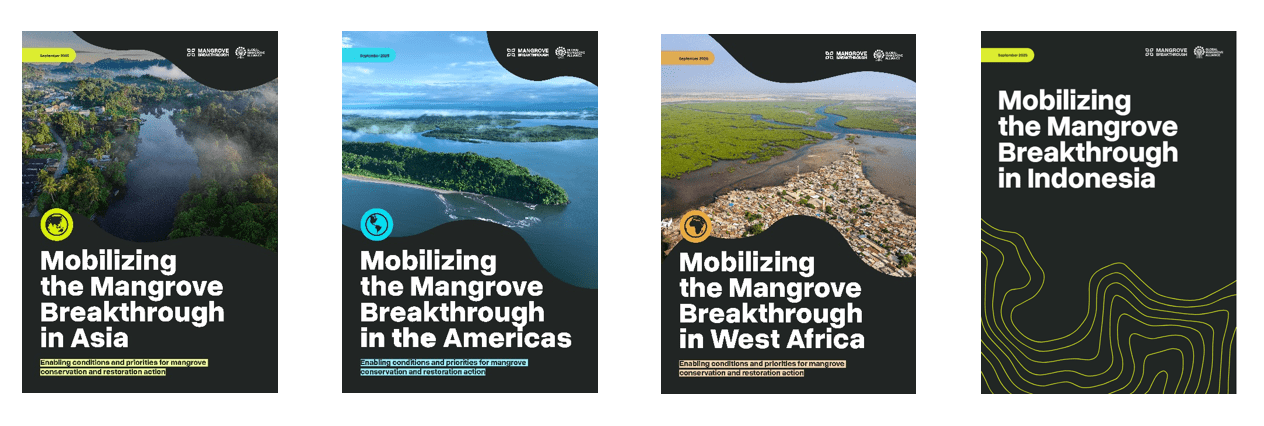Press release: New reports reveal where and how Asia, the Americas and West Africa can best conserve and restore their mangroves
New York, 22 September 2025 — As climate threats intensify and biodiversity loss accelerates, a new set of reports released today during New York Climate Week highlight how countries in Asia, the Americas and West Africa can combat the rapid loss of mangroves —vital ecosystems that play a crucial role in climate adaptation and resilience, yet are disappearing at an alarming rate.
Produced by the Global Mangrove Alliance and the Mangrove Breakthrough, the Regional Readiness Reports map regional trends, threats, as well as conservation and restoration potential and show the far-reaching impacts for climate, biodiversity, and sustainable development in nations with high mangrove cover.
“These reports answer the critical question of where and how we can most effectively accelerate mangrove action,” said Irene Kingma, Wetlands International. “They point funders and decision-makers to opportunities and to places and partners ready to move.”
Mangroves store up to four times more carbon than tropical rainforests, shield coastal communities from rising seas and storms, and provide vital habitat for over 340 threatened species. Yet, over 50% of their original extent has already been lost, and efforts to conserve and restore them remain severely underfunded.
To close this gap, Mangrove Breakthrough partners are mobilizing $4 billion in public, private, and philanthropic finance to halt mangrove loss, restore half of degraded mangroves, and double their protection by 2030. These Regional Reports translate its Finance Roadmap into tangible, high-impact investment opportunities across the three critical regions.
“The Regional Readiness Reports are blueprints to help donors, financial institutions, governments and NGOs align their resources and commitments—advancing the Mangrove Breakthrough into its next phase, driving system-level change across target regions, and delivering tangible benefits for frontline coastal communities and ecosystems”, added Ignace Beguin, Director of the Mangrove Breakthrough.
Left: Coenraad Krijger, CEO Wetlands International handing over the Mobilizing the Mangrove Breakthrough Regional Report to Alicia Bárcena, Minister for Environment and Natural Resources of Mexico
Right: Alicia Bárcena with Pilar Jacobo, WWF Mexico and Camila Zepeda, Mexico’s Chief Climate and Biodiversity Negotiator, posing with the new Regional Readiness Report
Critical regions and countries to achieve the Mangrove Breakthrough targets
The reports spotlight regions and countries that stand out with restoration potential or potential to increase mangrove protected area. Asia is home to around 40% of the world’s remaining mangroves. With 3,927 km² of restorable mangroves, the region could deliver nearly half (47%) of the global Mangrove Breakthrough restoration target. Around 27% of mangroves in Asia are under some form of formal protection. Due to the globally significant mangrove area in Indonesia, doubling protection levels there, would realize more than half of the Mangrove Breakthrough’s regional goal. Across Asia, conversion of mangrove forests to shrimp aquaculture ponds and agricultural plantations is the largest driver of loss and resolving land tenure is the most common barrier to effective action.
Home to nearly 28% of the world’s mangroves, the Americas region holds vast potential for restoration, with nearly 1,800 km² of restorable mangroves (22% of the global restoration target), particularly in Mexico, Brazil and Colombia. However, restoration efforts are often hindered by land tenure disputes and insufficient funding. While approximately 70% of mangroves are already under formal protection, effective and well-resourced management at a landscape level is crucial that these protections lead to meaningful outcomes.
West Africa holds the world’s third largest mangrove area, vital for food, fuel, and coastal protection. The Regional Readiness Report shows the region has 14% of global restoration potential and urgent need for expanded protection. Nine of twelve countries already recognize mangroves in their commitments, under the Global Biodiversity Framework, underscoring strong political will to ensure the mangroves of the region remain in a healthy state. This is however one of the world’ s least developed regions with many challenges related to poverty. Conservation strategies for this region should be centred around improving livelihoods as part of an overall strategy.
Overcoming recurrent barriers for upscaling
To overcome the recurrent barriers that limit both the scalability and long-term sustainability of interventions, the reports identify four critical enablers: to mobilize mangrove partnerships, incubate finance and investment, enhance policies and governance, and build local knowledge and capacities.
For high-impact countries, the reports also summarize existing mangrove positive policies and governance structures, enabling finance mechanisms and existing partnerships, identifying where immediate support and investment can have the greatest effect.
The Mobilizing the Mangrove Breakthrough Regional Reports and Country Summary for Indonesia can be downloaded here. The West Africa Regional Report will be available soon; further Country Summaries for Asia, the Americas and West Africa will be added prior to COP30.
The reports were developed with support from the Bezos Earth Fund.

Media Inquiries
Sam Goodman
Communications Director, Mangrove Breakthrough
sam.goodman@ambitionloop.earth
+57 3104815586
Irene Kingma
Senior Technical Officer
Wetlands International
irene.kingma@wetlands.org